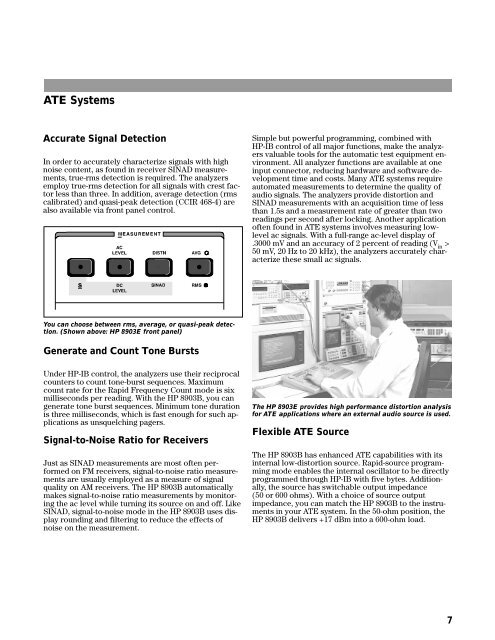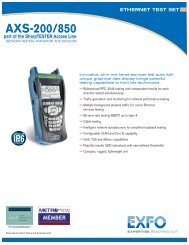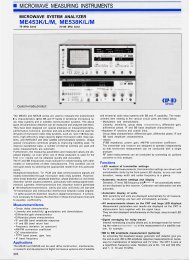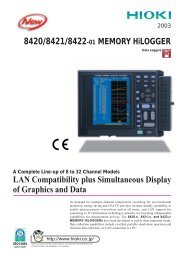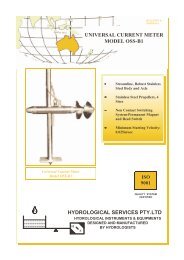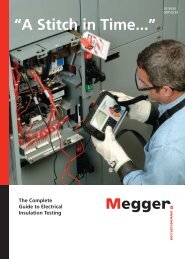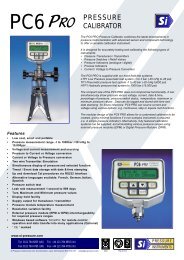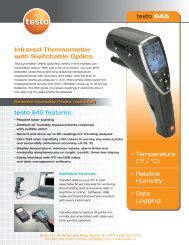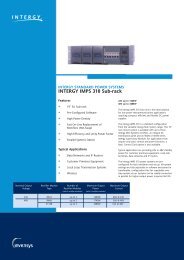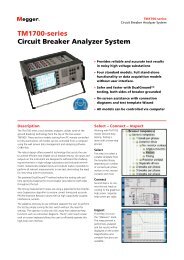HP 8903B Specifications
HP 8903B Specifications
HP 8903B Specifications
Create successful ePaper yourself
Turn your PDF publications into a flip-book with our unique Google optimized e-Paper software.
ATE Systems<br />
Accurate Signal Detection<br />
In order to accurately characterize signals with high<br />
noise content, as found in receiver SINAD measurements,<br />
true-rms detection is required. The analyzers<br />
employ true-rms detection for all signals with crest factor<br />
less than three. In addition, average detection (rms<br />
calibrated) and quasi-peak detection (CCIR 468-4) are<br />
also available via front panel control.<br />
Simple but powerful programming, combined with<br />
<strong>HP</strong>-IB control of all major functions, make the analyzers<br />
valuable tools for the automatic test equipment environment.<br />
All analyzer functions are available at one<br />
input connector, reducing hardware and software development<br />
time and costs. Many ATE systems require<br />
automated measurements to determine the quality of<br />
audio signals. The analyzers provide distortion and<br />
SINAD measurements with an acquisition time of less<br />
than 1.5s and a measurement rate of greater than two<br />
readings per second after locking. Another application<br />
often found in ATE systems involves measuring lowlevel<br />
ac signals. With a full-range ac-level display of<br />
.3000 mV and an accuracy of 2 percent of reading (V in<br />
><br />
50 mV, 20 Hz to 20 kHz), the analyzers accurately characterize<br />
these small ac signals.<br />
You can choose between rms, average, or quasi-peak detection.<br />
(Shown above: <strong>HP</strong> 8903E front panel)<br />
Generate and Count Tone Bursts<br />
Under <strong>HP</strong>-IB control, the analyzers use their reciprocal<br />
counters to count tone-burst sequences. Maximum<br />
count rate for the Rapid Frequency Count mode is six<br />
milliseconds per reading. With the <strong>HP</strong> <strong>8903B</strong>, you can<br />
generate tone burst sequences. Minimum tone duration<br />
is three milliseconds, which is fast enough for such applications<br />
as unsquelching pagers.<br />
Signal-to-Noise Ratio for Receivers<br />
Just as SINAD measurements are most often performed<br />
on FM receivers, signal-to-noise ratio measurements<br />
are usually employed as a measure of signal<br />
quality on AM receivers. The <strong>HP</strong> <strong>8903B</strong> automatically<br />
makes signal-to-noise ratio measurements by monitoring<br />
the ac level while turning its source on and off. Like<br />
SINAD, signal-to-noise mode in the <strong>HP</strong> <strong>8903B</strong> uses display<br />
rounding and filtering to reduce the effects of<br />
noise on the measurement.<br />
The <strong>HP</strong> 8903E provides high performance distortion analysis<br />
for ATE applications where an external audio source is used.<br />
Flexible ATE Source<br />
The <strong>HP</strong> <strong>8903B</strong> has enhanced ATE capabilities with its<br />
internal low-distortion source. Rapid-source programming<br />
mode enables the internal oscillator to be directly<br />
programmed through <strong>HP</strong>-IB with five bytes. Additionally,<br />
the source has switchable output impedance<br />
(50 or 600 ohms). With a choice of source output<br />
impedance, you can match the <strong>HP</strong> <strong>8903B</strong> to the instruments<br />
in your ATE system. In the 50-ohm position, the<br />
<strong>HP</strong> <strong>8903B</strong> delivers +17 dBm into a 600-ohm load.<br />
7


